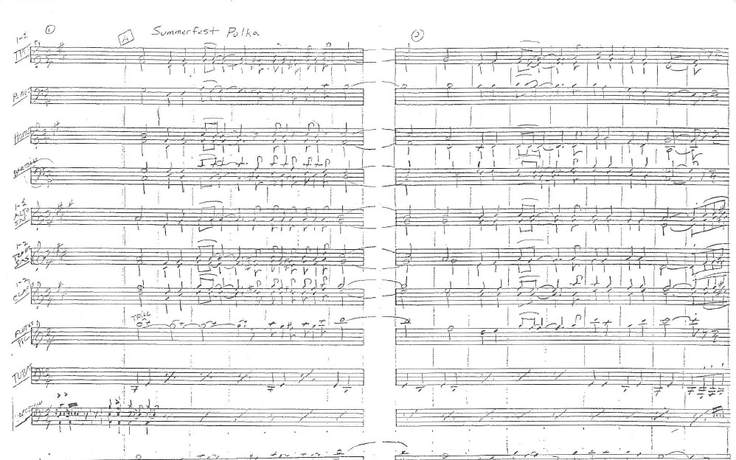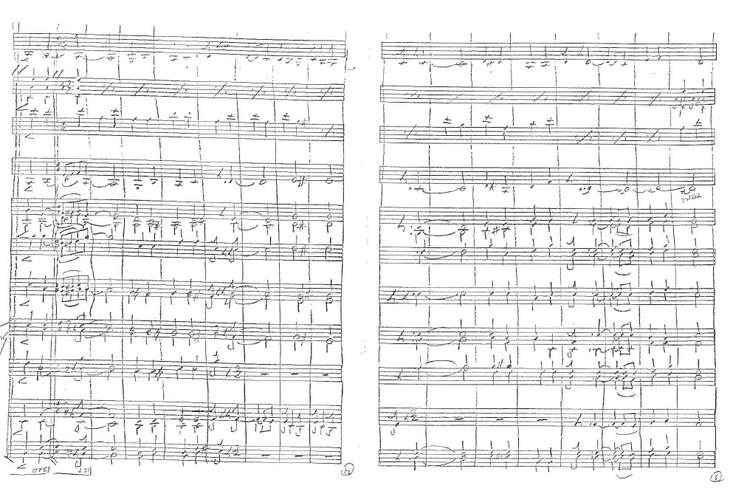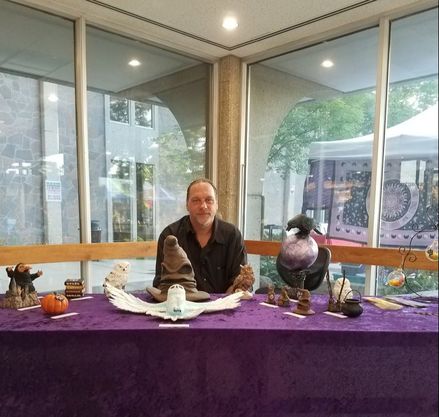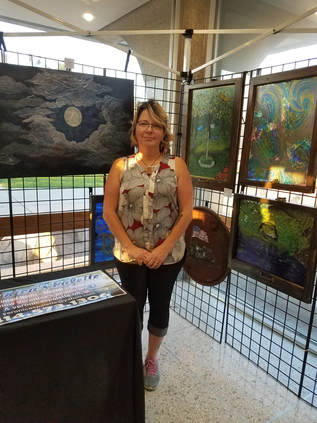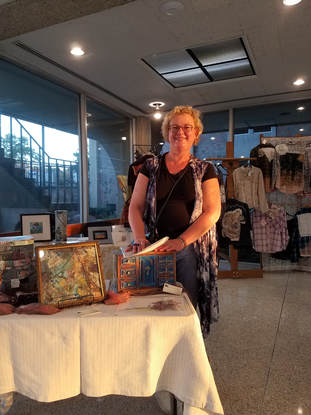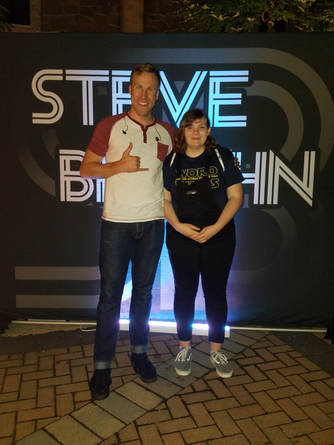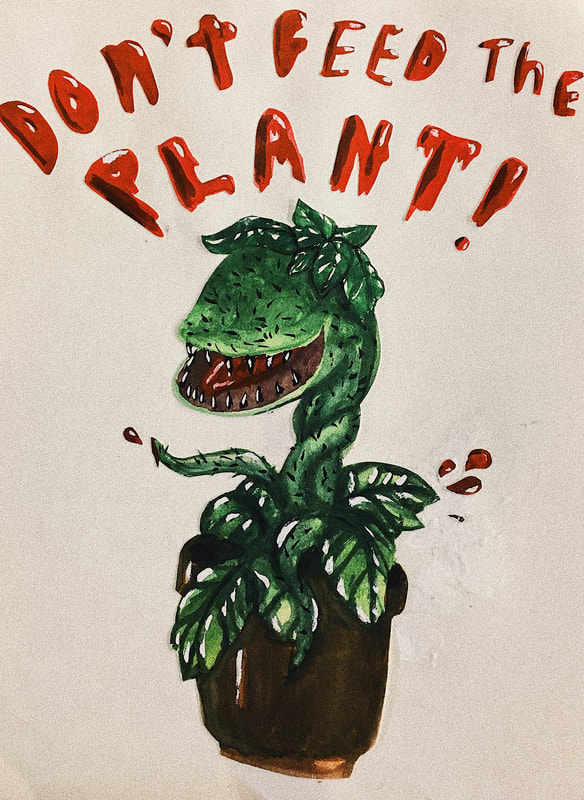Review: Senior Collaborative Projects
Written By Freedom Gobel
I attended Reagan’s 2018 Fall One Acts on October 5. Two intermissions and three acts later, I had watched a collection of six One Acts and Senior Collaborative Projects. While last year’s performance featured emotionally similar pieces, this year brought on a plethora of reactions.
Difficulties at Disney: Character Crisis
This piece had both desirable and distracting qualities. First and foremost, the breakdown of relationships between each of the characters was unbalanced and occasionally confusing. While the dad (played by Ethan Nepper) and his following spirit (played by Gabrielle Vitrano) established what their association entails from the exposition of the piece, the father/daughter relationship (between Nepper and Stephanie Perez Villafuerte) was inconsistent. During some scenes, the two characters embodied a realistic family appearance but then dropped that success in pivotal moments, becoming… acquaintances with an age difference?
Vitrano, though occasionally over-dramatic, seemed to develop her character with the greatest success. Her presence was often where my attention ended up, even during instances when her character wasn’t the intended focal point. Interestingly, her acting improved as the show progressed and she became visibly more comfortable in her character by the end of the performance. While Vitrano’s character was comedic in a theatrical sense, Nepper proved an advanced ability to display relatable humor. His occasional ‘one-liners’ sent the entire audience into the biggest laughing fits of the act. Perez Villafuerte was necessary to the story and played her character as one would expect upon reading the script. Jackson McCoy, though only appearing for limited amounts of time and having the least amount of lines, used body language that showed his natural ability in theatre.
Dolled Up
Creepy, creepy, CREEPY. As each character made their dramatic, door-slamming entrance, chills were sent up my spine. Alekzander Timmerman’s character, the first to walk through the audience and onto the stage, gave an incredibly intriguing, tension-filled introduction to this piece. Mary (played by Celeste Dickson) staggered on the stage, and instantly, everyone in the audience knows she’s broken. One by one, each of the four characters (adding Julia Matiszik and Julian Hall) makes their way to the set.
Timmerman demands power instantly and consistently, while Dickson’s character never breaks out of a slave-like distress. Matiszik’s character, though emotionally stronger than Dickson’s, remains submissive to to Timmerman’s; the same goes for Hall. The tension is palpable as the power figure practices control over every individual at the so-called friendly gathering, treating each almost like a doll. Hmm.
Good acting is fine and expected, but great acting is captivating —— this is exacting what Dickson’s accomplished. From the words she uttered to the shaking of her hands when Timmerman approached her, she perfectly demanded the attention of the audience. Based on her performance in last year’s One Acts, I knew she was probably one of the theatre department’s more naturally gifted members, but this performance sealed the deal.
I’m always interested in seeing Matiszik’s work. Though I hoped to see her play a more vulnerable character for her possibly last high school performance, her well-practiced cold demeanor was, as expected, strong and chilling. What sparked inquiry throughout her performance was her ability to switch between more or less charismatic personalities. In a script with an unclear background (wonderfully artistic), the audience is forced to question the meaning behind the scene, which kept me unblinking and focused on every word. What are the thematic battles… Good vs bad? Dominance vs submission? Men vs women? Perhaps, it’s all of the above, and Matiszik, more than any other character, guided this thematic train of thought in her changing attitudes with each person.
For my final comment… the broken wine glass? Loved it.
BOYZ II (wo) MEN
This Collaborative Project was incredibly well-rounded. Each actor was equally successful in comedic delivery, which was the most impressive quality of this piece. I had a smile on my face the entire time I was watching, not necessarily because something funny was said, but because I was charmed by the humorous environment.
The “jock” (played by Katie Gillingham), was the first to make conversation with the sad boy (played by Lauren O’Hear). I’ve seen all of Gillingham’s performances since the beginning of her IB Theater career, and this one is by far my favorite yet. Perhaps the character was written for her or she just simply nailed it, but this performance was exceptionally well done. I could say the same for the second conversation starter (Alanna Bielawski), who (while mumbling at times) used perfectly fitting dialogue to enhance the appeal of her character. The last speaker (Jazmin Reyes) did a decent job too, displaying an aggressive contrast from the other two. My favorite of the group was O’Hear. Plainly put, she is really great at being real. Nothing was over dramatic or screamed MUSICAL THEATER —— I felt as if I could meet this person in a public setting on a normal day in my life.
Interestingly, hidden within the folds of laughter and comedy was a conversation on a much more serious note: feminism. As each undercover “boy” approached the sad and disappointed male that had been discouraged over a certain female at a dance, subtopics of gender inequalities were brought up: Is the purpose of women allowing men to use them? Is shallowness the only way to make connection between these sexes? What does it mean to be a woman in a man’s world? I applaud the script and direction in this piece for turning a topic with such a controversial reputation into a comedic, educational work of art.
Difficulties at Disney: Character Crisis
This piece had both desirable and distracting qualities. First and foremost, the breakdown of relationships between each of the characters was unbalanced and occasionally confusing. While the dad (played by Ethan Nepper) and his following spirit (played by Gabrielle Vitrano) established what their association entails from the exposition of the piece, the father/daughter relationship (between Nepper and Stephanie Perez Villafuerte) was inconsistent. During some scenes, the two characters embodied a realistic family appearance but then dropped that success in pivotal moments, becoming… acquaintances with an age difference?
Vitrano, though occasionally over-dramatic, seemed to develop her character with the greatest success. Her presence was often where my attention ended up, even during instances when her character wasn’t the intended focal point. Interestingly, her acting improved as the show progressed and she became visibly more comfortable in her character by the end of the performance. While Vitrano’s character was comedic in a theatrical sense, Nepper proved an advanced ability to display relatable humor. His occasional ‘one-liners’ sent the entire audience into the biggest laughing fits of the act. Perez Villafuerte was necessary to the story and played her character as one would expect upon reading the script. Jackson McCoy, though only appearing for limited amounts of time and having the least amount of lines, used body language that showed his natural ability in theatre.
Dolled Up
Creepy, creepy, CREEPY. As each character made their dramatic, door-slamming entrance, chills were sent up my spine. Alekzander Timmerman’s character, the first to walk through the audience and onto the stage, gave an incredibly intriguing, tension-filled introduction to this piece. Mary (played by Celeste Dickson) staggered on the stage, and instantly, everyone in the audience knows she’s broken. One by one, each of the four characters (adding Julia Matiszik and Julian Hall) makes their way to the set.
Timmerman demands power instantly and consistently, while Dickson’s character never breaks out of a slave-like distress. Matiszik’s character, though emotionally stronger than Dickson’s, remains submissive to to Timmerman’s; the same goes for Hall. The tension is palpable as the power figure practices control over every individual at the so-called friendly gathering, treating each almost like a doll. Hmm.
Good acting is fine and expected, but great acting is captivating —— this is exacting what Dickson’s accomplished. From the words she uttered to the shaking of her hands when Timmerman approached her, she perfectly demanded the attention of the audience. Based on her performance in last year’s One Acts, I knew she was probably one of the theatre department’s more naturally gifted members, but this performance sealed the deal.
I’m always interested in seeing Matiszik’s work. Though I hoped to see her play a more vulnerable character for her possibly last high school performance, her well-practiced cold demeanor was, as expected, strong and chilling. What sparked inquiry throughout her performance was her ability to switch between more or less charismatic personalities. In a script with an unclear background (wonderfully artistic), the audience is forced to question the meaning behind the scene, which kept me unblinking and focused on every word. What are the thematic battles… Good vs bad? Dominance vs submission? Men vs women? Perhaps, it’s all of the above, and Matiszik, more than any other character, guided this thematic train of thought in her changing attitudes with each person.
For my final comment… the broken wine glass? Loved it.
BOYZ II (wo) MEN
This Collaborative Project was incredibly well-rounded. Each actor was equally successful in comedic delivery, which was the most impressive quality of this piece. I had a smile on my face the entire time I was watching, not necessarily because something funny was said, but because I was charmed by the humorous environment.
The “jock” (played by Katie Gillingham), was the first to make conversation with the sad boy (played by Lauren O’Hear). I’ve seen all of Gillingham’s performances since the beginning of her IB Theater career, and this one is by far my favorite yet. Perhaps the character was written for her or she just simply nailed it, but this performance was exceptionally well done. I could say the same for the second conversation starter (Alanna Bielawski), who (while mumbling at times) used perfectly fitting dialogue to enhance the appeal of her character. The last speaker (Jazmin Reyes) did a decent job too, displaying an aggressive contrast from the other two. My favorite of the group was O’Hear. Plainly put, she is really great at being real. Nothing was over dramatic or screamed MUSICAL THEATER —— I felt as if I could meet this person in a public setting on a normal day in my life.
Interestingly, hidden within the folds of laughter and comedy was a conversation on a much more serious note: feminism. As each undercover “boy” approached the sad and disappointed male that had been discouraged over a certain female at a dance, subtopics of gender inequalities were brought up: Is the purpose of women allowing men to use them? Is shallowness the only way to make connection between these sexes? What does it mean to be a woman in a man’s world? I applaud the script and direction in this piece for turning a topic with such a controversial reputation into a comedic, educational work of art.
The Ins and Outs of the Husky Fight Song
Written By Diego de Haan
The Husky Fight song has quickly become a symbol of school pride. The catchy tune has been stuck in the heads of students. The song was introduced at the beginning of the school year. In collaboration between the band, orchestra, choir, and band director, Adam Murphy, the Husky Fight song was made. Now, at sports games, on the morning announcements, and all around the school, the song is constantly being played.
The origins of the Husky Fight song goes back to 1969 and Milwaukee Mayor Henry Maier. Unlike modern politicians, Maier was popular for singing. He had written a song called the “Summerfest Polka”, commemorating the annual Summerfest. The song became a symbol of summer Milwaukee. That leads up to May of earlier in the year. The Milwaukee Public Schools Biennial Music Festival was planned to take place at Summerfest.
Ben Zabor, chair of art and music at Rufus King High School came across a band arrangement for the Summerfest Polka by prior MPS teacher Ron DeVillers and Mike Van Pelt. In honor of the song, it was planned to play the Summerfest Polka at Summerfest and to have it conducted by Ron DeVillers himself. Unfortunately, rain resulted in the festival being canceled and never was rescheduled.
Reagan’s band director, Mr. Murphy, constantly talks about a quote from Picasso, “Good artists copy; great artists steal.” After the performance, Murphy took the catchy tune and wanted to make it into the Reagan fight song. With permission from Mike Van Pelt, the arrangement was ‘stolen’ in hope to become the Reagan fight song. From there, the band and orchestra classes all worked together to develop lyrics to the piece. The lyrics were then introduced to the choir. During August of 2018, the new Husky Fight Song debuted at the first football game of the year. Murphy said, “We probably played the fight song 60 times.” Shortly after, in early September, the advanced choir, band, and orchestra filmed a performance of the fight song.
While the song is new to Reagan, the search for a piece has been ongoing. Four years ago, two students composed a song to be the school fight song. However, the song was missing lyrics and was extremely challenging to play. Unfortunately, the piece had to be dropped. With the new piece, it is easy for starters in band and orchestra to play, allowing it to be more enjoyable for everyone.
The Husky Fight song is going to live on as a part of Reagan. It will continue part of Reagan culture. In fact, the cheerleaders have a dance to the song that has the possibility to last for decades. It is a representation of school spirit and pride. Murphy elaborated the inclusivity and diversity in the song: “The lyrics of our fight song have a phrase in Spanish and in English; it is accepting and supportive of multiple languages.” He even mentioned the attempt to add French phrases, but having a hard time having syllables match up. The Husky Fight song will continue to be enjoyed in Reagan history, hopefully as much as it is being enjoyed right now.
The origins of the Husky Fight song goes back to 1969 and Milwaukee Mayor Henry Maier. Unlike modern politicians, Maier was popular for singing. He had written a song called the “Summerfest Polka”, commemorating the annual Summerfest. The song became a symbol of summer Milwaukee. That leads up to May of earlier in the year. The Milwaukee Public Schools Biennial Music Festival was planned to take place at Summerfest.
Ben Zabor, chair of art and music at Rufus King High School came across a band arrangement for the Summerfest Polka by prior MPS teacher Ron DeVillers and Mike Van Pelt. In honor of the song, it was planned to play the Summerfest Polka at Summerfest and to have it conducted by Ron DeVillers himself. Unfortunately, rain resulted in the festival being canceled and never was rescheduled.
Reagan’s band director, Mr. Murphy, constantly talks about a quote from Picasso, “Good artists copy; great artists steal.” After the performance, Murphy took the catchy tune and wanted to make it into the Reagan fight song. With permission from Mike Van Pelt, the arrangement was ‘stolen’ in hope to become the Reagan fight song. From there, the band and orchestra classes all worked together to develop lyrics to the piece. The lyrics were then introduced to the choir. During August of 2018, the new Husky Fight Song debuted at the first football game of the year. Murphy said, “We probably played the fight song 60 times.” Shortly after, in early September, the advanced choir, band, and orchestra filmed a performance of the fight song.
While the song is new to Reagan, the search for a piece has been ongoing. Four years ago, two students composed a song to be the school fight song. However, the song was missing lyrics and was extremely challenging to play. Unfortunately, the piece had to be dropped. With the new piece, it is easy for starters in band and orchestra to play, allowing it to be more enjoyable for everyone.
The Husky Fight song is going to live on as a part of Reagan. It will continue part of Reagan culture. In fact, the cheerleaders have a dance to the song that has the possibility to last for decades. It is a representation of school spirit and pride. Murphy elaborated the inclusivity and diversity in the song: “The lyrics of our fight song have a phrase in Spanish and in English; it is accepting and supportive of multiple languages.” He even mentioned the attempt to add French phrases, but having a hard time having syllables match up. The Husky Fight song will continue to be enjoyed in Reagan history, hopefully as much as it is being enjoyed right now.
Video of the Husky Fight Song by advanced band, orchestra, and choir: |
|
Recording of the Summerfest Polka:
|
|
Art at the Plaza
Written by Alex Romero
‘Art at the Plaza’ is a local art show that comes around once a year and is held at the West Allis City Hall Art Gallery. While this year’s turn out was a bit small, the people still had smiles on their faces.
At ‘Art at the Plaza’, local artists set up booths to show off and sell their artwork. During this event, there was live music and even booths where you could create your own art and find more art events around Wisconsin. Below are just a few of the artists featured at the event:
At ‘Art at the Plaza’, local artists set up booths to show off and sell their artwork. During this event, there was live music and even booths where you could create your own art and find more art events around Wisconsin. Below are just a few of the artists featured at the event:
Brian Vallery finds his inspiration from many sci-fi and fantasy movies he has watched over the years. One movie in particular inspires him most: Harry Potter. Vallery describes his art as more of an obsession, or something he has to do because he loves it so much. Vallery also does shows at various other places around Milwaukee along with other artists.
Veronica Shmauz explained how art came to her when she made ceramics at first and discovered she loved to paint, then turning to using recycled items such as window panes, old wood, and old mannequins to create her art. She also uses different cultures and natural sites in Wisconsin to inspire her work. She expressed that art was a great way for her to unwind and relax. She uses art as a way to take a break from her children when she gets the free time.
Lynnea Schliesleder believes that art is subjective to each person. As she grew up, she lived overseas and her mother was an artist, which sparked her creative side at a young age. Schliesleder believes that through art you can show people the world through your eyes. Art isn't about talent, it's about finding ideas you personally find beautiful and putting them into your work.
Music is another form of art, as seen by one of Steve Beguhn performances. Beguhn started music in his early life, but as he grew older he fell out of it. What inspired him to start music again was the death of one of his nearest friends. Beguhn said his friend always supported his music and pushed him to continue. Soon, Beguhn auditioned for American Idol. He did make it in but his dreams were cut short when he was eliminated. However, that didn’t break his spirit. He now does inspirational talks for local school choirs and performs shows. Music is once again one main aspect of his life.
‘Art at the plaza’ comes around once a year, enticing people with their art and live music. This year was an interesting success, and will likely be next year too!
‘Art at the plaza’ comes around once a year, enticing people with their art and live music. This year was an interesting success, and will likely be next year too!
Noteworthy: Paul McCartney, Egypt Station
Written By Preston Carr
By all accounts, rock music currently occupies a peculiar place in its history. Once the unquestioned monarch of all popular music genres, rock now majorly lags behind hip hop in its cultural relevance. This leaves the unquestioned (living) monarch of rock, his Beatleness Sir Paul McCartney, with no particular place to go. Such is the weakness of McCartney’s brand new blockbuster record, Egypt Station.
If there’s anybody that’s been around the block a couple times, it’s Paul McCartney. After all, he was a Beatle, and a songwriting Beatle at that. If you enjoy “Let It Be,” “Eleanor Rigby,” “Lady Madonna,” “Yesterday,” “Black Bird,” (there are plenty I’m forgetting, if you can believe it) then you have Sir McCartney to thank. Simply put, he is one of the greatest songwriters to have ever lived. Though there is certainly a debate to be had over whether the Beatles are overrated (they are regularly referred to as the greatest band of all time), it is impossible to deny their incalculable influence on popular music. I, personally, believe that the Beatles’ music has a remarkable and singular way of tapping into something approaching universal appeal.
This history, unfortunately for McCartney, makes the lack of creativity on Egypt Station especially perplexing. Don’t get me wrong--the record is by no means bad, but it pales in comparison to McCartney’s other work.
The first track on the album is a 42 second instrumental intro, fittingly titled “Opening Station.” It’s nothing to write home about particularly, but once one gets past the cliche street noises, it provides a pleasant bit of choral work. Nothing crazy, or as far as I can see, significant, but a 30 second choral arrangement is better than no choral arrangement if you ask me. Next is “I Don’t Know,” probably the best song on the record. Its prominent juxtaposition of major and minor harmonies keeps the ear interested, while McCartney’s signature penchant for catchy hooks shines through. It’s a little on the cheesy side, but I do not fault a 76 year-old singer of a bygone era for such an offense.
Following “I Don’t Know” is the lead single off the album, “Come On To Me,” a fairly traditional Pop-Rock romper (in other words, familiar territory for post-Beatles Paul). I have one major grievance with this song: save for a short riff-based bridge, the entire tune is built off of a mind-numbingly simple two-bar chord progression (G - C - F - G, for the weirdos whom are interested). Even during the pre-chorus, rather than change up the harmony to build tension, the song instead adds more instruments playing the same chord progression. It gets very boring, very fast. Again, context is McCartney’s enemy on this album, because I cannot help but recall that the same man wrote the several-part rollercoaster of harmony and melody that is “Martha, My Dear.” Where in the world did that creativity, that spark of genius run off to?
Things aren’t quite as disappointing on the next cut, “Happy With You,” which, despite its unfortunate lyrical triteness and striking instrumental similarity to “Blackbird,” is quite nice. The B section is particularly satisfying, and a welcome thoughtful reprieve from the emptiness of “Come On To Me.”
Now we must surmount this record’s thorny crown, the elephant in the station: “Fuh You.” Produced and co-written by smash singer, songwriter, and frontman of OneRepublic, Ryan Tedder, McCartney was clearly looking for a big radio hit when he made this one. And boy, is it bad. I think the song’s description speaks for itself: it is a teenage pop party anthem written by an affluent (though well-meaning) seventy-six year-old who happens to be on his third wife. It is generic, uninteresting, insincere, and seeps the phrase “How do you do, fellow kids?” from its very bones. The apex of this track’s badness comes during the chorus, wherein McCartney sings gleefully, “I just wanna know how you feel / Want a love that’s so proud and real / You make me wanna go out and steal / I just want it fuh you, I just want it fuh you.” It is very important to note that, by what is certainly no accident, the last line sounds dubiously like a certain other phrase that conjures up less innocent images of romance (they called it “Fuh You” and not “For You” for a reason). Not only is this poor, heavy-handed lyric writing, but the whole grossness of the situation is amplified by McCartney’s sudden ugly falsetto that appears when he belts the last line. Suffice to say, the song’s not good.
“Suddenly / I’m not half the man I used to be / There’s a shadow hanging over me / Oh, yesterday came suddenly.” On Egypt Station, the majority of Paul McCartney’s creativity and originality appears to have been left for yesterday. There are certainly good moments on the album, but it is a mere speck in comparison to the musical giants that comprise the rest of McCartney’s discography. I guess rock and its king are just getting old.
If there’s anybody that’s been around the block a couple times, it’s Paul McCartney. After all, he was a Beatle, and a songwriting Beatle at that. If you enjoy “Let It Be,” “Eleanor Rigby,” “Lady Madonna,” “Yesterday,” “Black Bird,” (there are plenty I’m forgetting, if you can believe it) then you have Sir McCartney to thank. Simply put, he is one of the greatest songwriters to have ever lived. Though there is certainly a debate to be had over whether the Beatles are overrated (they are regularly referred to as the greatest band of all time), it is impossible to deny their incalculable influence on popular music. I, personally, believe that the Beatles’ music has a remarkable and singular way of tapping into something approaching universal appeal.
This history, unfortunately for McCartney, makes the lack of creativity on Egypt Station especially perplexing. Don’t get me wrong--the record is by no means bad, but it pales in comparison to McCartney’s other work.
The first track on the album is a 42 second instrumental intro, fittingly titled “Opening Station.” It’s nothing to write home about particularly, but once one gets past the cliche street noises, it provides a pleasant bit of choral work. Nothing crazy, or as far as I can see, significant, but a 30 second choral arrangement is better than no choral arrangement if you ask me. Next is “I Don’t Know,” probably the best song on the record. Its prominent juxtaposition of major and minor harmonies keeps the ear interested, while McCartney’s signature penchant for catchy hooks shines through. It’s a little on the cheesy side, but I do not fault a 76 year-old singer of a bygone era for such an offense.
Following “I Don’t Know” is the lead single off the album, “Come On To Me,” a fairly traditional Pop-Rock romper (in other words, familiar territory for post-Beatles Paul). I have one major grievance with this song: save for a short riff-based bridge, the entire tune is built off of a mind-numbingly simple two-bar chord progression (G - C - F - G, for the weirdos whom are interested). Even during the pre-chorus, rather than change up the harmony to build tension, the song instead adds more instruments playing the same chord progression. It gets very boring, very fast. Again, context is McCartney’s enemy on this album, because I cannot help but recall that the same man wrote the several-part rollercoaster of harmony and melody that is “Martha, My Dear.” Where in the world did that creativity, that spark of genius run off to?
Things aren’t quite as disappointing on the next cut, “Happy With You,” which, despite its unfortunate lyrical triteness and striking instrumental similarity to “Blackbird,” is quite nice. The B section is particularly satisfying, and a welcome thoughtful reprieve from the emptiness of “Come On To Me.”
Now we must surmount this record’s thorny crown, the elephant in the station: “Fuh You.” Produced and co-written by smash singer, songwriter, and frontman of OneRepublic, Ryan Tedder, McCartney was clearly looking for a big radio hit when he made this one. And boy, is it bad. I think the song’s description speaks for itself: it is a teenage pop party anthem written by an affluent (though well-meaning) seventy-six year-old who happens to be on his third wife. It is generic, uninteresting, insincere, and seeps the phrase “How do you do, fellow kids?” from its very bones. The apex of this track’s badness comes during the chorus, wherein McCartney sings gleefully, “I just wanna know how you feel / Want a love that’s so proud and real / You make me wanna go out and steal / I just want it fuh you, I just want it fuh you.” It is very important to note that, by what is certainly no accident, the last line sounds dubiously like a certain other phrase that conjures up less innocent images of romance (they called it “Fuh You” and not “For You” for a reason). Not only is this poor, heavy-handed lyric writing, but the whole grossness of the situation is amplified by McCartney’s sudden ugly falsetto that appears when he belts the last line. Suffice to say, the song’s not good.
“Suddenly / I’m not half the man I used to be / There’s a shadow hanging over me / Oh, yesterday came suddenly.” On Egypt Station, the majority of Paul McCartney’s creativity and originality appears to have been left for yesterday. There are certainly good moments on the album, but it is a mere speck in comparison to the musical giants that comprise the rest of McCartney’s discography. I guess rock and its king are just getting old.
Little Shop of Horrors
Written By Elias Barnes and Soepe Ya
“Little Shop of Horrors” is a fantasy and science fiction movie that was released in 1996 that follows the events of a man-eating plant. The movie is set in a city referred to as Skid Row, with the main character, Seymour. Seymour is described as a nerdy florist with an ever growing obsession for plants. The movie starts off with Audrey 2 already in Seymours possession. Audrey 2 is a Venus fly trap who presented itself to Seymour unbenounced to him during a solar eclipse. Seymour then, frustrated with his life and with his job, yells and sings to the plant telling it to grow, but in the process of doing this cuts himself on a rose. Audrey 2 then starts to “salivate” over the blood and Seymore then reluctantly drips it into his mouth.
After these events the plant begins to grow and Seymour’s life starts to get better. Due to the plant more customers are shopping at Mushnik’s Flower Shop, earning him and his terrible boss a greater profit. Mr. Mushnik, then yells at Seymour, wanting him to make the plant bigger and bigger. Seymore than cuts his fingers and let’s the plant suck the blood out of him making it grow larger than it ever was before, until one day it is not enough.
In addition to that, Seymour likes a girl named Audrey but the only problem is that she is in a abusive relationship with Orin Scrivello, the dentist . The plant sees this as an opportunity for food. Unfortunately, Mr. Mushnik sees Seymour doing something very traumatizing and the next day holds him at gunpoint. Unbeknownst to Mr. Mushnik, Audrey 2 is behind him signaling Seymour to lead him towards the open mouth of Audrey 2. Once Mr. Mushnik gets close enough the plant eats him alive. After this, the plant almost doubles in size, bringing along a lot of publicity to the shop.
This makes Seymour and his new found wife Audrey very overwhelmed and they plan to leave town and escape Skid Row. The plant finds out about their plans and tricks Audrey into getting too close. Just before he swallows her whole, Seymour comes to the rescue and saves her. Seymour and the plant then have one final duel, ending very dramatically. He and Audrey then leave the town and move away, which unknowingly then leads to another plot twist.
After these events the plant begins to grow and Seymour’s life starts to get better. Due to the plant more customers are shopping at Mushnik’s Flower Shop, earning him and his terrible boss a greater profit. Mr. Mushnik, then yells at Seymour, wanting him to make the plant bigger and bigger. Seymore than cuts his fingers and let’s the plant suck the blood out of him making it grow larger than it ever was before, until one day it is not enough.
In addition to that, Seymour likes a girl named Audrey but the only problem is that she is in a abusive relationship with Orin Scrivello, the dentist . The plant sees this as an opportunity for food. Unfortunately, Mr. Mushnik sees Seymour doing something very traumatizing and the next day holds him at gunpoint. Unbeknownst to Mr. Mushnik, Audrey 2 is behind him signaling Seymour to lead him towards the open mouth of Audrey 2. Once Mr. Mushnik gets close enough the plant eats him alive. After this, the plant almost doubles in size, bringing along a lot of publicity to the shop.
This makes Seymour and his new found wife Audrey very overwhelmed and they plan to leave town and escape Skid Row. The plant finds out about their plans and tricks Audrey into getting too close. Just before he swallows her whole, Seymour comes to the rescue and saves her. Seymour and the plant then have one final duel, ending very dramatically. He and Audrey then leave the town and move away, which unknowingly then leads to another plot twist.
|
Students that are interested in auditioning for the musical “Little Shop of Horrors” should consider how time consuming it is. Specific dates students should memorize are October 16 and October 29, the first “workshop”. During this informational meeting, students will be given all the materials needed in order to audition. Between these two dates, student should have memorized all the acts in order to audition later that week. In addition, October 30 is to be specifically designated to the singing auditions. While as the 31 of October and November 1 will be specifically for the acting and dancing portions of the auditions.
|
Even Serial Killers Lives Next Door To Someone
Written By Elysium Morss
From the release of Pac Man to Jeffrey Dahmer, lots happened in the 80s’. Though we’re currently in 2018, it seems like the aesthetic of the 80s’ is slowing being merged back into society and with the new release of the movie Summer of 84’, people are wondering why. Stephen Smith, Co-Screenwriter of Summer of 84’, talked to Husky Howler reporter, Elysium Morss, about his new movie and his thoughts on why the aesthetic of the 80’s might be coming back.
Smith’s theory on the 80’s coming back is simple really. “The 80’s were such a unique time period, There was no way to google search someone. Technology wasn’t as advanced as it is now.” There was no smartphones or Wikipedia.
Smith said that his movie was like a “love letter to the movies [I] watched growing up”. Some movies that he loved growing up included The Burb’s, Fright Night, Stand by Me, and Lost Boys. All of these movies had some inspiration for the movie. The four boys in Stand by Me inspires his band of kids in Summer of 84’. “There was the bad boy kid, the nerd, the kind of heavy kid, and the main boy who is intrigued by the unknown.”
SPOILER WARNING!
The murderer in the movie was inspired by a few well-known serial killers from the 70s and 80s. Killers like Ted Bundy and John Wayne Gacy with how they stored and buried the bodies. A killer who was anonymous and admitted to their crimes like The Zodiac Killer. A friend of the other screen writer, lived down the street from Jeffrey Dahmer and the idea that a murder could “live just down the street from you and you’d never know what they were doing in the house” helped create the murderer as well.
Though all these killers had their own signature way to kill, Mackey has his own too. Storing his victims—teen boys, normally the age of 15—in a locked bathroom in his basement while they rot. Then using the chemical, NaOH—sodium hydroxide—to get rid of the stench and burying them in his backyard was his signature way to kill.
Smith’s theory on the 80’s coming back is simple really. “The 80’s were such a unique time period, There was no way to google search someone. Technology wasn’t as advanced as it is now.” There was no smartphones or Wikipedia.
Smith said that his movie was like a “love letter to the movies [I] watched growing up”. Some movies that he loved growing up included The Burb’s, Fright Night, Stand by Me, and Lost Boys. All of these movies had some inspiration for the movie. The four boys in Stand by Me inspires his band of kids in Summer of 84’. “There was the bad boy kid, the nerd, the kind of heavy kid, and the main boy who is intrigued by the unknown.”
SPOILER WARNING!
The murderer in the movie was inspired by a few well-known serial killers from the 70s and 80s. Killers like Ted Bundy and John Wayne Gacy with how they stored and buried the bodies. A killer who was anonymous and admitted to their crimes like The Zodiac Killer. A friend of the other screen writer, lived down the street from Jeffrey Dahmer and the idea that a murder could “live just down the street from you and you’d never know what they were doing in the house” helped create the murderer as well.
Though all these killers had their own signature way to kill, Mackey has his own too. Storing his victims—teen boys, normally the age of 15—in a locked bathroom in his basement while they rot. Then using the chemical, NaOH—sodium hydroxide—to get rid of the stench and burying them in his backyard was his signature way to kill.
